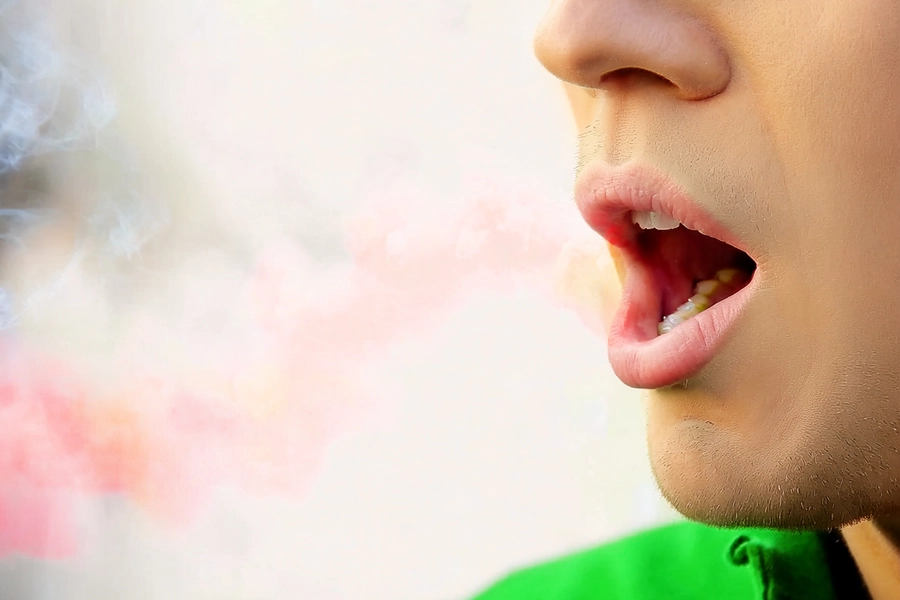Bad breath, also known as Halitosis, is a common condition that most individuals experience at some point in their lives. While it can be an embarrassing concern, is it solely a result of poor oral hygiene or could it indicate an underlying health issue?
In this article, we will explore the underlying causes of bad breath and the preventive measures you can take to manage and eliminate it.
What is bad breath?
Bad breath (Halitosis) is characterized by an unpleasant odor in exhaled air.1 For many individuals, halitosis can be an embarrassing condition that negatively impacts their confidence and social interactions. Chronic bad breath may create challenges in personal and professional relationships, leading to self-consciousness and withdrawal from conversations. Bad breath can be caused by a variety of factors, with its severity often depending on the underlying cause. While bad breath is typically temporary and can be easily managed, chronic halitosis may be a sign of more serious health issues that require attention. Halitosis is classified into three main categories: genuine halitosis, pseudo-halitosis and halitophobia.1
1. Genuine Halitosis: This type of halitosis involves the presence of a noticeable, unpleasant odor in the breath, which is socially unacceptable. It is further subdivided into:
a. Physiologic Halitosis: This is temporary bad breath that occurs due to natural processes, such as morning breath or breath after consuming certain foods (like garlic or onions). It is not usually a sign of an underlying health issue.
b. Pathologic Halitosis: This type of halitosis is persistent and may be a sign of a health problem. Pathologic halitosis is divided into:2
b.1) Oral Halitosis: Caused by poor oral hygiene, gum disease, tooth decay or infections in the mouth.
b.2) Extraoral Halitosis: Originates from sources outside the mouth, such as gastrointestinal issues (like acid reflux), respiratory infections or systemic conditions like diabetes or liver disease.
2. Pseudo-Halitosis: This condition occurs when a person perceives themselves to have bad breath, but clinical tests reveal no detectable malodor. These patients may complain of bad breath, but others cannot detect it. Pseudo-halitosis can typically be treated by dental practitioners.
3. Halitophobia: This is a psychological condition where a person believes they have bad breath, even though no actual odor is present. It is a form of fear or anxiety related to the perception of bad breath. Halitophobic patients require psychological counseling or therapy to address their concerns, as dental treatments are not effective.
Causes and Preventive Measures
Some of the causes of bad breath and the corresponding precautions include:
1. Poor Oral Hygiene:
These bacteria are most abundant in the posterior (back) region of the tongue, which has a complex papillary structure that forms “cratered” surfaces. This surface facilitates the retention of bacteria, further contributing to bad breath.1
Preventive Measures: Brush your teeth at least twice a day, floss daily and clean your tongue with a tongue scraper. Regular visits to the dentist for check-ups and cleanings are also essential because routine dental visits ensure that your oral health is monitored and any issues like cavities, gum disease or plaque buildup are addressed. Professional cleaning also removes tartar, which cannot be removed by regular brushing and help prevent oral health issues that can lead to bad breath.
2. Dry Mouth:
Additionally, saliva contains important minerals like calcium and phosphate that contribute to keeping the teeth strong and protecting against tooth decay. 4 Dry mouth can occasionally occur due to temporary factors such as nervousness or stress. However, persistent dry mouth can be caused by the side effects of certain medications, underlying conditions such as Sjögren’s disease, HIV/AIDS and diabetes, or by treatments like radiation therapy, chemotherapy and immunotherapy. Nerve damage can also contribute to the condition.
Preventive Measures: To manage dry mouth effectively, there are several preventive measures you can adopt. First, it’s important to drink plenty of water throughout the day to stay hydrated and promote saliva production. Chewing sugar-free gum, particularly those containing xylitol, can also help stimulate saliva flow, preventing tooth decay.
If you suspect that medications are causing dry mouth, consult your healthcare provider for possible alternatives. Using a humidifier in your bedroom at night can keep the air moist and reduce dryness while you sleep. Additionally, avoiding alcohol and caffeine helps prevent dehydration, while breathing through your nose instead of your mouth can keep your mouth moist.
Quitting tobacco products and using alcohol-free mouthwash will prevent dryness and protect oral health. Lastly, maintaining good oral hygiene by brushing twice a day, flossing and using fluoride toothpaste will help prevent further complications associated with dry mouth.
3. Diet Related:
4. Infections in Mouth:
a. Dental Caries (Tooth Decay): Cavities form when bacteria in the mouth feed on sugars and produce acids that erode the enamel. As decay progresses, bacteria accumulate in the damaged areas, leading to infection and bad breath.
b. Periodontal (Gum) Disease: Gum infections occur due to plaque buildup along the gumline, leading to inflammation, bleeding and deep pockets where bacteria and food debris collect. This bacterial overgrowth emits foul-smelling compounds, worsening breath odor.
c. Mouth Sores and Ulcers: Conditions such as oral thrush, herpes sores or other infections can cause tissue breakdown and bacterial growth, contributing to halitosis.
d. Surgical Wounds: After tooth extractions or oral surgeries, bacteria can accumulate in healing wounds if proper oral hygiene is not maintained, leading to infection and an unpleasant smell.
Preventive Measures: Brushing your teeth at least twice a day, cleaning your tongue and flossing daily help remove bacteria that can produce foul-smelling compounds, as well as plaque buildup, which can contribute to tooth decay and gum disease, both common causes of bad breath. Additionally, using an alcohol-free mouthwash helps to eliminate odor-causing bacteria and freshen breath.
Regular dental check-ups are crucial for detecting and addressing oral health problems early. During these visits, dentists can identify dental caries (tooth decay), gum disease or other oral infections that may lead to bad breath. Early intervention helps prevent these conditions from worsening, reducing the risk of chronic halitosis and the need for more invasive treatments later. Finally, timely treatment of infections is essential in managing bad breath and maintaining oral health.
5. Health Conditions:
Chronic bad breath can sometimes be a sign of underlying health conditions beyond oral hygiene. Certain systemic diseases such as diabetes, liver disease and kidney disease, can contribute to bad breath due to metabolic imbalances.1 For instance, uncontrolled diabetes can lead to a fruity or acetone-like breath odor caused by the buildup of ketones in the body. Similarly, liver disease can result in a distinct musty or sweet smell due to the accumulation of toxins that the liver fails to filter out, while kidney disease may produce a urine-like or ammonia-scented breath.
Infections in the respiratory system such as those affecting the nose, throat or lungs, can also lead to bad breath.3 Conditions like chronic sinusitis, postnasal drip and chronic bronchitis create an environment where mucus and bacteria accumulate, leading to foul-smelling breath. Additionally, disturbances in the digestive system, such as acid reflux (GERD), can cause stomach acids to flow back into the esophagus and mouth, producing a sour or unpleasant odor.
Preventive Measures: To effectively manage halitosis, it is essential to identify and address any underlying medical conditions through a thorough evaluation by a healthcare professional. Proper diagnosis and targeted treatment of systemic diseases, respiratory infections or gastrointestinal disorders contributing to bad breath are crucial. Additionally, maintaining optimal oral hygiene including regular brushing, flossing and professional dental care plays a vital role in minimizing halitosis. A comprehensive approach that combines medical management with diligent oral care can significantly improve breath odor and overall health.
6. Smoking and Tobacco Use:
Smoking contributes to bad breath through multiple mechanisms, primarily by altering the oral microbiome, reducing saliva flow and introducing foul-smelling chemical compounds into the body. Cigarette smoke contains toxic substances that lower oxygen levels and exert antibiotic effects, disrupting the balance of normal, healthy bacteria in the mouth.6 This disruption allows harmful bacteria to thrive, leading to gum disease, tooth decay and dry mouth, all of which contribute to bad breath.
Additionally, smoking decreases saliva production (hyposalivation), which is essential for cleansing the mouth and neutralizing odor-causing bacteria. Reduced salivary flow facilitates bacterial accumulation, enhances biofilm formation on oral tissues and weakens the host’s immune response, further predisposing individuals to chronic oral infections and malodor.
Beyond these biological effects, certain components of tobacco combustion are absorbed into the bloodstream through the oral and lung mucosa.7 These substances are later exhaled through the lungs, contributing to the characteristic stale odor known as smoker’s breath.6 The intensity of this odor varies depending on the type of tobacco used, with cigar and pipe smokers experiencing even stronger halitosis than cigarette smokers.7
Overall, smoking not only alters the natural bacterial environment in the mouth but also reduces the body’s ability to cleanse itself, leading to persistent and difficult-to-eliminate bad breath.
Preventive Measures: Managing tobacco-related halitosis begins with smoking cessation. Quitting smoking allows the body to gradually restore its natural defenses, improving saliva flow and reducing bacterial overgrowth. In addition to cessation, maintaining proper oral hygiene is essential in mitigating the effects of smoking on breath odor. Brushing twice daily, flossing and using alcohol-free mouthwash help to remove odor-causing bacteria, plaque buildup and residual tobacco compounds from the mouth. Tongue cleaning is particularly important, as bacteria and volatile compounds can accumulate on its surface, exacerbating bad breath.
Furthermore, professional dental care plays a crucial role in addressing smoking-related oral health issues. Regular dental check-ups and cleanings help to detect and treat gum disease, dental caries and biofilm accumulation, all of which contribute to halitosis. In cases where periodontal disease has developed, specialized treatments may be required to manage inflammation and bacterial infections effectively. By combining smoking cessation, rigorous oral hygiene and professional dental care, individuals can significantly reduce tobacco-related halitosis.
Conclusion
Bad breath or Halitosis is a multifactorial condition influenced by oral hygiene, dietary habits, underlying health conditions and lifestyle choices such as smoking. While temporary bad breath is common and often manageable with proper oral care, persistent halitosis may indicate deeper oral or systemic health issues that require professional attention. Addressing the root cause, whether it is poor oral hygiene, dry mouth, infections, dietary factors or medical conditions is essential for effective management.
Preventive measures, including maintaining optimal oral hygiene, staying hydrated, making dietary modifications and seeking medical or dental care when necessary, can help to control and eliminate bad breath. For individuals who smoke, quitting tobacco is crucial not only for improving breath freshness but also for promoting oral and systemic health. By adopting a comprehensive approach to oral care and addressing contributing factors, individuals can significantly reduce their bad breath, enhancing their confidence and overall well-being.
References
- Khounganian RM, Alasmari ON, Aldosari MM, Alghanemi NM. Causes and Management of Halitosis: A Narrative Review. Cureus. 2023 Aug 19;15(8):e43742. https://pmc.ncbi.nlm.nih.gov/articles/PMC10506127/
- Murata T, Yamaga T, Iida T, Miyazaki H, Yaegaki K. Classification and examination of halitosis. Int Dent J. 2002 Jun;52 Suppl 3:181-6. https://pubmed.ncbi.nlm.nih.gov/12090449/#:~:text=Halitosis%20is%20classified%20into%20categories,into%20oral%20and%20extraoral%20halitosis.
- American Dental Association (ADA) Division of Science. Bad breath. The Journal of the American Dental Association.2012;143(9):1053. https://jada.ada.org/article/S0002-8177(14)61845-6/fulltext
- National Institute of Dental and Craniofacial Research. Dry Mouth. NIH. Updated on: October 2024. Accessed on March 8, 2025. Available from: https://www.nidcr.nih.gov/health-info/dry-mouth
- Dr PPC Lee. The aetiology and treatment of oral halitosis: an update. Hong Kong Med J 2004;10:414-418. https://toothgood.com/wp-content/uploads/2016/04/Oral-Halitosis.pdf
- Comparing the impact of cigarettes and smoke free products on halitosis:Literature review.Oral Health. Published on Jul 18, 2024. Accessed on March 9,2025. Available from: https://www.pmiscience.com/en/research/literature-reviews/tobacco-halitosis/#:~:text=In%20their%20meta%2Danalysis%20summarizing,oxygen%20levels%20and%20antibiotic%20effects.
- Kauss AR, Antunes M, Zanetti F, Hankins M, Hoeng J, Heremans A, van der Plas A. Influence of tobacco smoking on the development of halitosis. Toxicol Rep. 2022 Mar 6;9:316-322. https://pmc.ncbi.nlm.nih.gov/articles/PMC8908054/#sec0035




